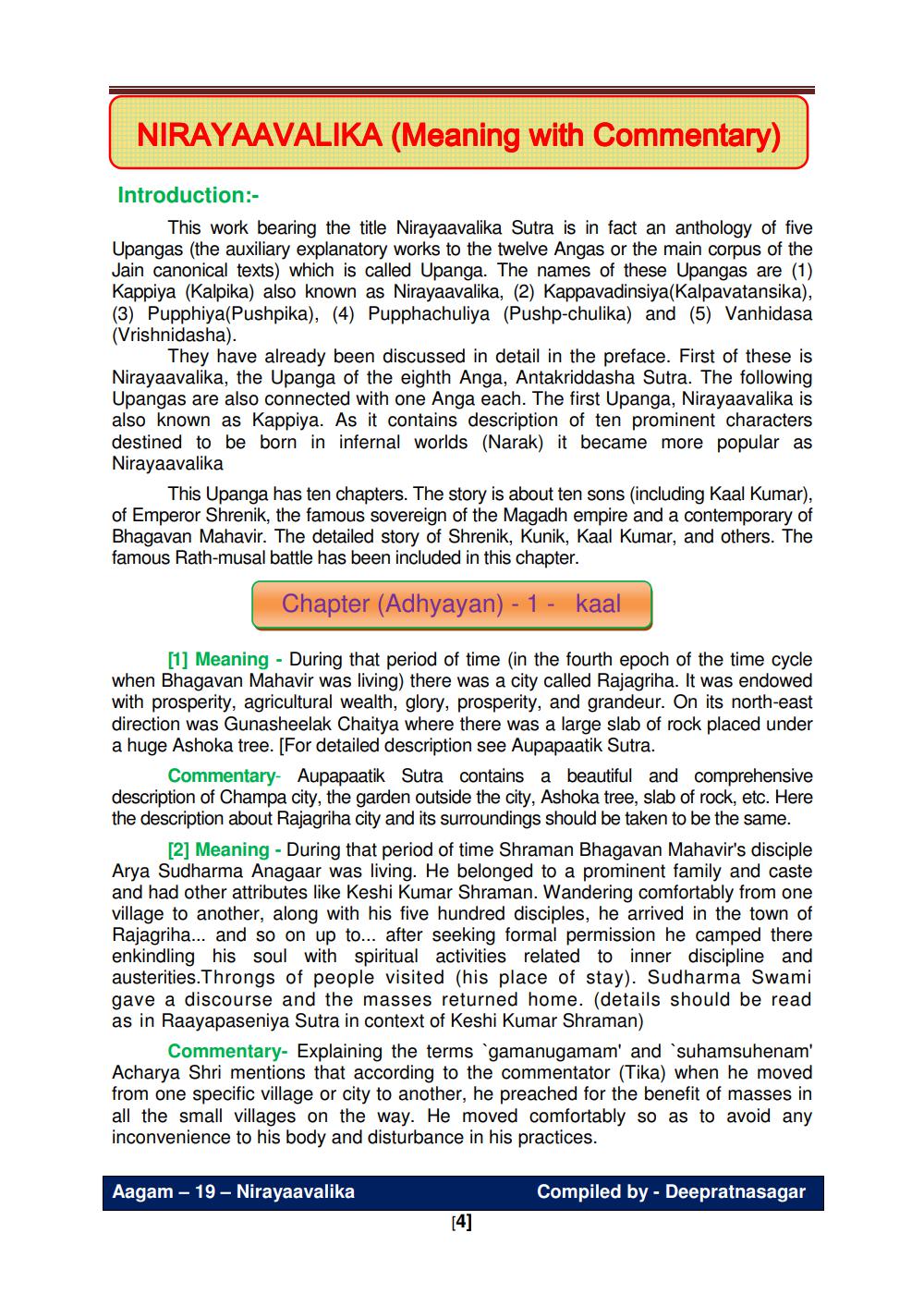Book Title: Agam 19 Upang 08 Niryavalika Sutra English Translation Author(s): Dipratnasagar, Deepratnasagar Publisher: Deepratnasagar View full book textPage 5
________________ NIRAYAAVALIKA (Meaning with Commentary) Introduction: This work bearing the title Nirayaavalika Sutra is in fact an anthology of five Upangas (the auxiliary explanatory works to the twelve Angas or the main corpus of the Jain canonical texts) which is called Upanga. The names of these Upangas are (1) Kappiya (Kalpika) also known as Nirayaavalika, (2) Kappavadinsiya(Kalpavatansika), (3) Pupphiya(Pushpika), (4) Pupphachuliya (Pushp-chulika) and (5) Vanhidasa (Vrishnidasha). They have already been discussed in detail in the preface. First of these is Nirayaavalika, the Upanga of the eighth Anga, Antakriddasha Sutra. The following Upangas are also connected with one Anga each. The first Upanga, Nirayaavalika is also known as Kappiya. As it contains description of ten prominent characters destined to be born in infernal worlds (Narak) it became more popular as Nirayaavalika This Upanga has ten chapters. The story is about ten sons (including Kaal Kumar), of Emperor Shrenik, the famous sovereign of the Magadh empire and a contemporary of Bhagavan Mahavir. The detailed story of Shrenik, Kunik, Kaal Kumar, and others. The famous Rath-musal battle has been included in this chapter. Chapter (Adhyayan) - 1 - kaal [1] Meaning - During that period of time in the fourth epoch of the time cycle when Bhagavan Mahavir was living) there was a city called Rajagriha. It was endowed with prosperity, agricultural wealth, glory, prosperity, and grandeur. On its north-east direction was Gunasheelak Chaitya where there was a large slab of rock placed under a huge Ashoka tree. [For detailed description see Aupapaatik Sutra. Commentary- Aupapaatik Sutra contains a beautiful and comprehensive description of Champa city, the garden outside the city, Ashoka tree, slab of rock, etc. Here the description about Rajagriha city and its surroundings should be taken to be the same. [2] Meaning - During that period of time Shraman Bhagavan Mahavir's disciple Arya Sudharma Anagaar was living. He belonged to a prominent family and caste and had other attributes like Keshi Kumar Shraman. Wandering comfortably from one village to another, along with his five hundred disciples, he arrived in the town of Rajagriha... and so on up to... after seeking formal permission he camped there enkindling his soul with spiritual activities related to inner discipline and austerities. Throngs of people visited (his place of stay). Sudharma Swami gave a discourse and the masses returned home. (details should be read as in Raayapaseniya Sutra in context of Keshi Kumar Shraman) Commentary. Explaining the terms 'gamanugamam' and 'suhamsuhenam' Acharya Shri mentions that according to the commentator (Tika) when he moved from one specific village or city to another, he preached for the benefit of masses in all the small villages on the way. He moved comfortably so as to avoid any inconvenience to his body and disturbance in his practices. Aagam - 19 - Nirayaavalika Compiled by - Deepratnasagar [4]Page Navigation
1 ... 3 4 5 6 7 8 9 10 11 12 13 14 15 16 17 18 19 20 21 22 23 24 25
